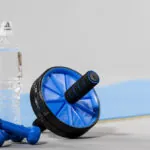Let’s face it – starting a calisthenics routine when you’re carrying some extra weight can be tough. Many popular calisthenics exercises require a certain level of strength and mobility that may seem out of reach at first.
But fear not! The beauty of calisthenics lies in its adaptability. Even if you can’t nail those flashy moves right away, there are plenty of modifications and progressions that can still help you build strength, burn fat, and improve your overall fitness level.
So, if you’re ready to embark on a journey of transformation, stick around as we explore how to get started with calisthenics and see progress fast, regardless of your current fitness level.
Don’t rush the progress
When starting calisthenics, it’s crucial to remember one golden rule: don’t rush the progress. It can be tempting to dive headfirst into popular exercises like push-ups, dips, or pull-ups, even if you can’t perform them with proper form. However, doing so can lead to a host of issues down the line. Incorrectly performing these exercises can put unnecessary strain on your muscles and joints, increasing the risk of injuries such as strains, sprains, or even more serious conditions.
Instead of pushing yourself to tackle advanced movements right off the bat, focus on adjusting these exercises to your current fitness level. By mastering the basics with proper form and gradually increasing the difficulty as you become more comfortable, you’ll not only reduce the risk of injuries but also build a solid foundation of strength and technique. Doing calisthenics properly makes it available for all body types and age groups. These safe calisthenics exercises are ideal for seniors.
In fact, if this routine proves to be too much, try easier exercises.
How to get started with calisthenics if you are struggling
Now you are going to learn how to modify popular calisthenics exercises to your fitness level.
Pull-ups
If you’re struggling with traditional pull-ups due to being overweight or lacking upper body strength, there are alternative methods to help you work towards mastering this challenging exercise. One effective way to build up to full pull-ups is by incorporating negative pull-ups into your routine.
Negative pull-ups involve focusing on the lowering (eccentric) portion of the movement, which helps build strength and control in the muscles required for a full pull-up. To perform negative pull-ups, start by using a stable platform or a chair to assist you in reaching the top position of the pull-up. Slowly lower yourself down in a controlled manner, aiming for a count of around 3-5 seconds.
Another option is to utilize resistance bands for assisted pull-ups. Loop a resistance band over the pull-up bar and place your foot or knee in the band to provide support as you pull yourself up. This method reduces the amount of body weight you have to lift, making it more manageable to work on your pull-up technique.
Push-ups
When it comes to calisthenics, push-ups are a fundamental exercise that targets multiple muscle groups, including the chest, shoulders, and triceps. However, for overweight individuals or those with limited upper body strength, traditional push-ups may pose a significant challenge.
One effective modification is to perform incline push-ups. By elevating your hands on a sturdy surface such as a bench, countertop, or even a wall, you can reduce the amount of body weight you need to lift, making the exercise more manageable. As you gradually build strength, you can lower the incline until you’re able to perform push-ups on the floor.
Another option is knee push-ups, where you lower your knees to the ground to reduce the amount of body weight being lifted. This modification allows you to focus on proper form and technique while still engaging the target muscles effectively.
Additionally, wall push-ups can be a great starting point for beginners. By standing a few feet away from a wall and leaning forward to perform push-ups against the wall, you can control the intensity of the exercise based on your proximity to the wall.
Dips
Dips are a fantastic bodyweight exercise that targets the triceps, chest, and shoulders, making them a great addition to any calisthenics routine.
If you can’t perform traditional dips, you can try bench dips. By using a sturdy bench, chair, or even the edge of a bed, you can perform dips with your feet on the ground and hands on the elevated surface. This reduces the amount of body weight you have to lift, making the exercise more achievable while still targeting the same muscle groups.
Another option is to use resistance bands for assisted dips. By looping a resistance band around the parallel bars or dip station and placing your knees or feet in the band for support, you can reduce the resistance and make the exercise more manageable while still challenging your muscles.
Squats
Squats are a fundamental lower body exercise that targets the quadriceps, hamstrings, glutes, and core muscles, making them a key component of any calisthenics routine.
A modification that works well is the chair squat. By using a sturdy chair or bench for support, you can practice squatting to a seated position before standing back up. This reduces the range of motion and helps you focus on proper form while building strength in your lower body muscles.
If starting these exercises turns out to be a bigger challenge than expected, try these easy exercises for obese people.
Final thoughts
Embarking on a calisthenics journey as an overweight individual may come with its challenges, but with patience, consistency, and the right mindset, progress is not only possible but inevitable.
If you find yourself struggling to stay consistent or motivated on your fitness journey, consider seeking the guidance of a personal trainer. A knowledgeable trainer can provide you with the support, accountability, and expertise needed to help you reach your fitness goals effectively and efficiently.
If you’re located in South Congaree or the surrounding areas, look no further than HiTone Fitness. Our team of experienced personal trainers is dedicated to helping individuals of all fitness levels achieve their goals. By visiting HiTone Fitness, you can get connected with a personal trainer who will develop a customized workout plan tailored to your specific needs and goals, keeping you on track and motivated every step of the way.





